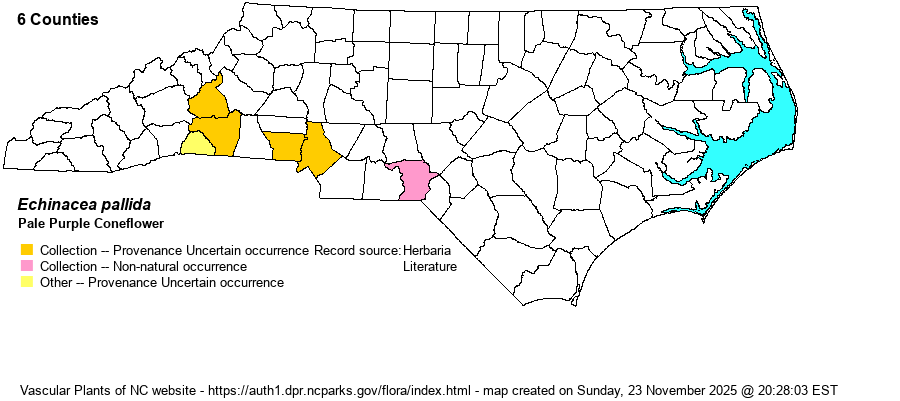| Author | (Nuttall) Nuttall | |
| Distribution | Southern Piedmont and foothills; the outlier record for Granville County in the northeastern Piedmont is now believed to be E. simulata. All NC records are highly likely to be adventive or escapes from cultivation, and the taxon editors recommend that it be treated as of uncertain provenance, if not non-native. Weakley (2024) also considers it as Uncertain Provenance in the Atlantic coast states, and that there is another Echinacea species -- E. simulata -- that might account for some of the NC records of E. pallida, as the two are very similar.
Primarily midwestern tallgrass prairies. Scattered records east of the Mississippi and Ohio Rivers are suspect as to origin. | |
| Abundance | Rare in the southwestern Piedmont, and very rare eastward. In 2024, the NCNHP moved the State Rank from S1 to SU (Undetermined), owing to a question whether it is native to NC or not. And, the State Status was moved by them from SR-D to now W4 (Rare but possibly not native). The website editors believe it may warrant a rank of SE? (questionably exotic). | |
| Habitat | Roadsides and disturbed sites: "roadbank at old home site" (Richmond Co.), "roadside waste area in Charlotte" (Mecklenburg Co.), "roadside" (Gaston Co.), "roadside ditch and sunny woodland edges" (Rutherford Co.), and "cleared upland woods" (McDowell Co.). In the Midwest it is a species of tallgrass prairies. | |
| Phenology | Flowering and fruiting June-July. All our purple coneflowers have been cultivated for medicinal purposes. | |
| Identification | Plants grow 1.5-3 feet tall, coarsely spreading-hairy. Leaves are lance-shaped to narrowly elliptic, 4-7 inches long and lacking teeth on the margins. The terminal heads have long, drooping, pale pink rays and a dull brownish yellow disk that becomes dome-shaped in age. The rough hairy stem and upper surface of the leaves separates it from E. laevigata. From E. purpurea it differs in its narrower leaves (2 cm or less wide vs. 3 cm or more wide). | |
| Taxonomic Comments | None
| |
| Other Common Name(s) | None | |
| State Rank | SU [SE?] | |
| Global Rank | G4 | |
| State Status | W4 | |
| US Status | | |
| USACE-agcp | | |
| USACE-emp | | |

